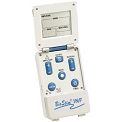
TENS, sometimes annotated as T.E.N.S., is an acronym for Transcutaneous Electrical Nerve Stimulation. TENS units are portable medical devices used to manage pain. These units offer an advanced, powerful form of pain management used by hundreds of thousands of people around the world, for the relief of physical pain.
Under patient control, a pocket sized, battery-operated device sends electrical impulses to parts of the body to block pain signals. The units offer a safe, noninvasive, drug-free method for relief of acute and chronic pain, post surgical pain, acute pain from sports and other injuries, the pain related to arthritis and many other conditions. TENS units should be used only under the direction of a doctor, physical therapist, or occupational therapist who will demonstrate proper usage and assist with appropriate device settings.
Rehabmart is pleased to present an assortment of superior quality TENS units from vendors including Mettler Electronics, Chattanooga, Independence Medical, DeRoyal, Fabrication Enterprises, Core Products International, Inc., McKesson Medical Surgical, Drive Medical, and ProMed Specialties.
Need help deciding? The 5 Best TENS Units


What is Physical Pain?
In essence, pain is your body’s built-in alarm to inform you that something is wrong. Pain is your body’s way of sending a warning to your brain through the pathways created by nerves and the spinal cord. Receptor nerve cells in and beneath your skin sense heat, cold, light, touch, pressure and pain. There are thousands of these receptor cells in your body, and most of them sense pain. Pain results from the stimulation of these specialized nerve endings.
The human body comprises a complex system of electrical signals that travel through an intricate pathway system of nerves. The communication between the brain and nerve receptors throughout the body is not completely understood, and continues to be studied. When there is an injury, the tiny receptor cells send messages along nerves into your spinal cord. The message then travels up your spinal cord to your brain. So pain travels along nerve pathways as electrical signals to and from areas of the body, through your spinal cord, to be interpreted by your brain.
Left unabated, pain takes a physical and emotional toll on patients, and can lead to ailments caused by physical and emotional stress. TENS unit are designed to interfere with the communication along nerve pathways, to help relieve the cycle of pain (COP) that can be interrupted by endorphins, distractions and electrical impulses as delivered by TENS.
How Do TENS Units Work to Relieve Pain?
TENS units use electrical nerve stimulation to block the transmission of pain signals to the brain. Large surface electrodes are taped to the skin to target the underlying nerves that supply the painful area. A small device used to stimulate the nerves for therapeutic purposes produces electrical current. The unit sends painless electrical signals through the electrodes to the nerves under your skin. The placement of electrodes depends on the type of pain, and its location.
There are generally two control knobs on a TENS unit. The first knob controls the strength of the electrical signal generated, from weak to strong. The second knob adjusts the fluctuation speed of the electrical signal, from slow to fast.
Under the patient’s control, the electrical current is gradually increased until a tingling sensation is felt. This feeling interrupts the transmission of pain signals to the brain. Your healthcare provider will work with you to determine proper placement of the unit’s electrodes, and to determine which signal strength and speed settings are best for your needs.
The purpose of the electrical signals produced by a TENS unit is to block the pain signals being sent to your brain. The stimulating pulses help prevent pain signals from reaching the brain, and also help stimulate your body to produce higher levels of its own natural painkillers, called endorphins.
What are Common Uses for TENS units?
TENS units are prescribed for both chronic pain conditions and acute pain. Pain associated with many types of illnesses and conditions may be relieved, such as:
Post operative incisions and post surgical pain.
Chronic pain from tendonitis and bursitis.
Muscle, joint or bone problems that occur with illnesses like osteoarthritis or fibromyalgia.
Conditions like lower back pain or neck pain.
Sudden acute pain such as labor and delivery pain.
Acute pain from sports and other injuries.
Are there Limitations on Who Should Use TENS Units?
A few minor risks are associated with TENS therapy. For instance, it should not be used if you have poor sensation, if you have cancer or if you have a pacemaker. It should never be used around the heart, on the head or over breast tissue. There is also a minor risk of skin irritation, but this is rare. Use TENS with caution for people with epilepsy or pregnant women. As always, follow your doctor’s advice. A prescription may be necessary for insurance reimbursement of a TENS unit.
For some chronic pain patients, a TENS unit provides pain relief lasting several hours. For others, a TENS unit may help reduce the amount of pain medications needed. Some units may be hooked onto a belt, making it portable so a patient may turn it on or off as needed. TENS units offer a better quality of life for people suffering from pain.
Hulet Smith, OT
Rehabmart Co-Founder & CEO
nrb